Simplified and Concise Note on Plant Hormones (elective biology)for SHS.
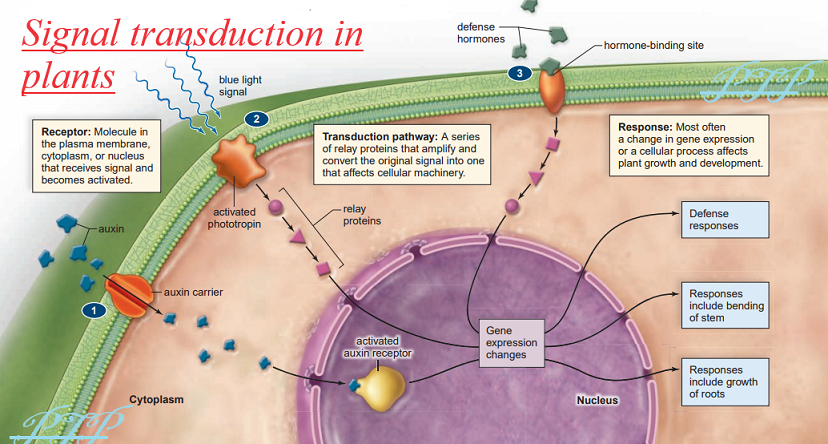
Simplified and concise note on Plant Hormones
Introduction
Flowering plants perceive and react to a variety of environmental stimuli.
Examples include light, gravity, carbon dioxide levels, pathogen infection, drought, and touch.
Responses can be short-term, as when stomata open and close in response to light levels.
Or long-term, as when they respond to gravity by the downward growth of the root and the upward growth of the stem.
Although we think of responses in terms of a plant part, the mechanism that brings about a response occurs at the cellular level (thus, it occurs in the cells of the plant).
Plant cells utilize signal transduction when they respond to stimuli. Signal transduction involves:
Receptors:
Receptors are molecules in the plasma membrane, cytoplasm, or nucleus that receive the signal and become activated.
They are proteins activated by a specific signal.
Receptors can be located in the plasma membrane, the cytoplasm, the nucleus, or even the endoplasmic reticulum.
Transduction pathway:
It is a series of relay proteins that amplify and convert the original signal into one that affects cellular machinery
Sometimes, a stimulated receptor immediately communicates with the transduction pathway, and in other instances, a second messenger, such as Ca2+, initiates the response.
Cellular response:
It occurs as a result of the transduction pathway.
Very often, the response is either the transcription of particular genes or the end product of an activated metabolic pathway.
The cellular response brings about the observed macroscopic response, such as stomata closing or a stem that turns toward the light.
Examples of signal transduction in plants.
- The hormone auxin enters the cell and is received by a receptor in the nucleus. This complex alters gene expression.
- A light receptor in the plasma membrane is sensitive to and activated by blue light. Activation leads to stimulation of a transduction pathway that ends with gene expression changes.
- When attacked by a herbivore, the flowering plant produces defense hormones that bind to a plasma membrane receptor. Again, the transduction pathway results in a change in gene expression.
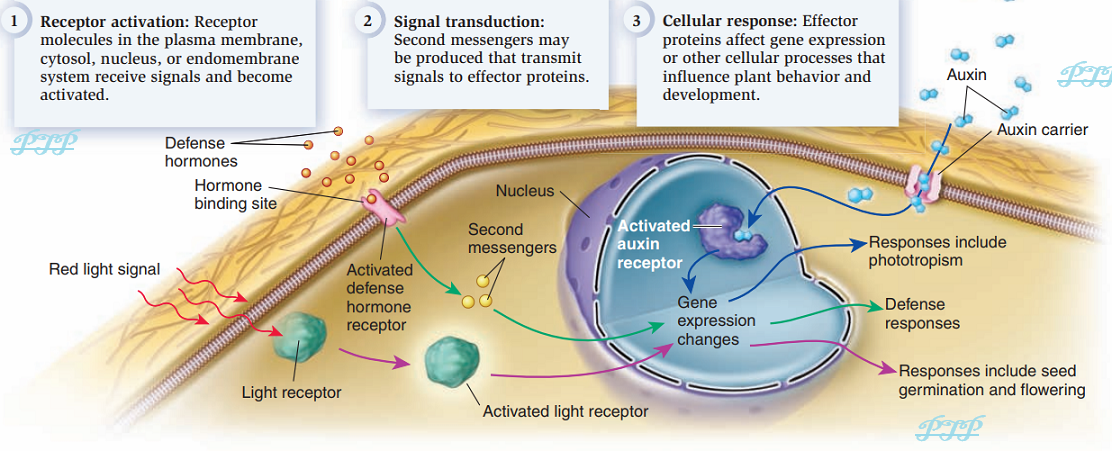
Plant Hormones
Plant hormones are chemical signals produced in very low concentrations and active in another part of the organism (plants).
Individual plant hormones often have multiple effects, and different concentrations or combinations of hormones can produce distinct growth or developmental responses.
Several plant hormones are known to act by causing the removal of gene repressors, thereby allowing gene expression to occur. This general mechanism allows hormones to cause relatively rapid responses.
Major types of plant hormones include;
1. Auxins:
Plants produce several types of auxins, which are considered to be the master plant hormones because they influence plant structure, development, and behaviour in many ways, often working with other hormones.
Auxins are produced in shoot apical meristem and are found in young leaves and flowers and fruits.
The most common naturally occurring auxin is Indoleacetic Acid (IAA).
- Auxin has many different effects on plants, one of which is to stimulate elongation of cells, which results in growth.
- It does this by stimulating proton pumps in cell surface membranes to remove protons from the cytoplasm and deposit them in the cell walls.
- This acidification of the cell walls loosens the bonds between the cellulose molecules and matrix, allowing the cell to elongate as it absorbs water.
Functions of Auxins.
- The application of an auxin paste to a stem cutting causes adventitious roots to develop more quickly than they would otherwise.
- Promotion of stem elongation and growth.
- Inhibition of leaf abscission.
- Promotion of cell division (with cytokinin).
- Inducement of ethylene production.
- Promotion of lateral bud dormancy.
- Stimulate fruit development
Synthetic auxins are used today in several applications.
- These auxins are sprayed on plants such as tomatoes to induce the development of fruit without pollination.
Thus, seedless tomatoes can be commercially developed.
- Synthetic auxins such as 2,4-D and 2,4,5-T have been used as herbicides to control broadleaf weeds, such as dandelions and other plants.
How Auxins Cause Stems to Bend
- When a stem is exposed to unidirectional light, auxin moves to the shady side, where it enters the nucleus and attaches to a receptor.
- The complex leads to the activation of a proton (H+) pump, and the resulting acidic conditions loosen the cell wall because hydrogen bonds are broken and cellulose fibrils are weakened by enzymatic action.
- The result of these activities is the elongation of the stem on the shady side so that it bends toward the light.
How auxin causes expansion of the cell wall.
- Auxin leads to the activation of a proton pump and the entrance of hydrogen ions in the cell wall.
- As the pH decreases, enzymes are activated and break down cellulose fibers in the cell wall.
- Cellulose fibers burst and the cell expands as turgor pressure inside the cell increases.

2. Gibberellins. (GA)
Gibberellins are named after the fungus Gibberella fujikuroi, which causes rice plants, on which it is parasitic, to grow abnormally tall.
There are about 70 known Gibberellins [L. gibbus, bent], and they differ chemically only slightly.
The most common of these is gibberellic acid, GA3 (the subscript designation distinguishes it from other gibberellins).
Gibberellins (GA) are produced in the embryos of germinating seeds, including wheat and barley after they have absorbed water.
GA switches on several genes that encode enzymes that hydrolyze food reserves.
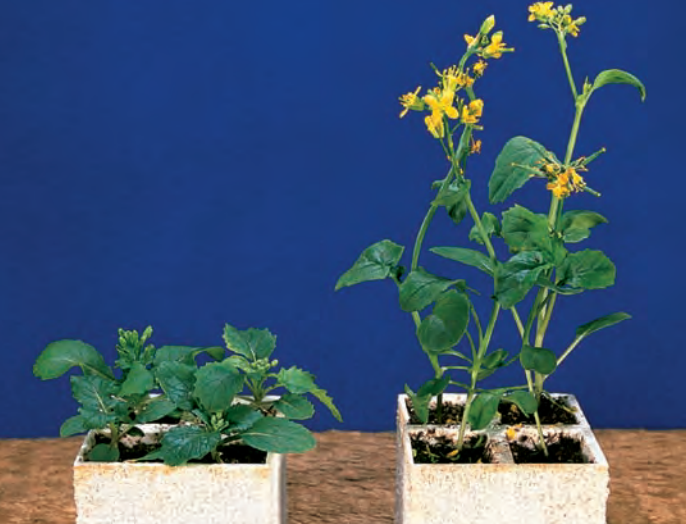
Functions
- Promotion of stem elongation.
- Stimulation of enzyme production in germinating seeds.
Commercially, gibberellins are helpful in a number of ways.
- Gibberellins induce the growth of plants and increase the size of flowers.
- Gibberellins have also been successfully used to produce larger seedless grapes.
- Gibberellins caused an increase in the space between the grapes, allowing them to grow larger.
- Gibberellins can break the dormancy of buds and seeds. Application of gibberellins is one way to hasten the development of a flower bud.
3. Cytokinins;
The cytokinins are derivatives of adenine, one of the purine bases in DNA and RNA.
Cytokinin is a plant hormone that, in combination with auxin, stimulates cell division and differentiation.
Most cytokinins are produced in the root apical meristems and transported throughout the plant.
Developing fruits are also important sites of cytokinin synthesis.
In mosses, cytokinins cause the formation of vegetative buds on the gametophyte.
In all plants, cytokinins, working with other hormones, seem to regulate growth patterns.
Cytokinins promote the growth of lateral buds into branches.
Conversely, cytokinins inhibit the formation of lateral roots, while auxins promote their formation.
The application of cytokinins to leaves detached from a plant retards their yellowing. Therefore, they function as antiaging hormones.
Cytokinins apparently promote the synthesis or activation of proteins specifically required for cytokinesis
How cytokinins stimulate lateral bud growth.
- When the apical meristem of a plant is intact, auxin from the apical bud will inhibit the growth of lateral buds.
- When the apical bud is removed, cytokinins are able to induce the growth of lateral buds into branches.
- When the apical bud is removed and auxin is added to the cut surface, lateral bud outgrowth is suppressed.

4. Abscisic Acid
Abscisic acid (ABA) is produced by any “green tissue” (that contains chloroplasts).
ABA is also produced in monocot endosperm and roots, where it is derived from carotenoid pigments.
Abscisic acid is sometimes called the stress hormone because it initiates and maintains seed and bud dormancy and brings about the closure of stomata.
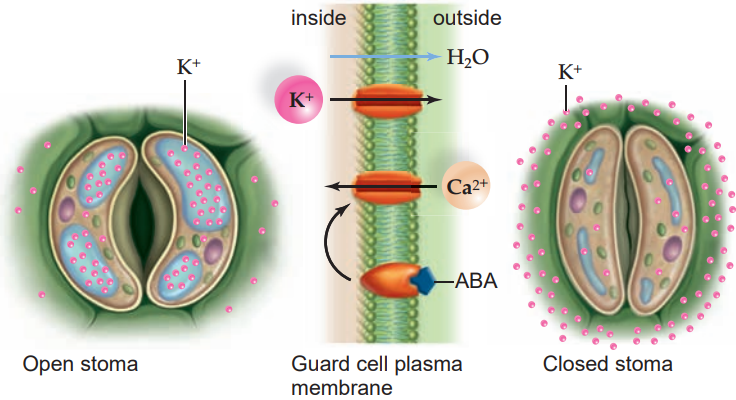
Dormancy is a period of low metabolic activity and arrested growth.
Dormancy occurs when a plant organ readies itself for adverse conditions by ceasing to grow (even though conditions at the time may be favorable for growth)
Abscisic acid plays a role in seed dormancy and is antagonistic to gibberellins during germination.
Abscisic acid levels in seeds rise during embryogenesis.
Note that Abscisic acid;
- Slows or stops metabolism during environmental stress,
- Induces bud and seed dormancy,
- Prevents seed germination in unfavorable conditions
- Promotes stomatal closing
5. Ethylene:
Ethylene (H2C = CH2) is a gas formed from the amino acid methionine. This hormone is involved in abscission and the ripening of fruits.
Ethylene Causes Abscission
- The absence of auxin, and perhaps gibberellin, probably initiates abscission.
- But once abscission has begun, ethylene stimulates certain enzymes, such as cellulase, which helps cause leaf, fruit, or flower drop.
Ethylene Ripens Fruit.
- The use of ethylene in agriculture is extensive.
- It is used to hasten the ripening of green fruits, such as melons and honeydews, and is also applied to citrus fruits to attain pleasing colours before marketing.
- Normally, tomatoes ripen on the vine because the plants produce ethylene.
- Today, tomato plants can be genetically modified to not produce ethylene.
- This facilitates shipping because green tomatoes are not subject to as much damage.
- Once the tomatoes have arrived at their destination, they can be exposed to ethylene so that they ripen.
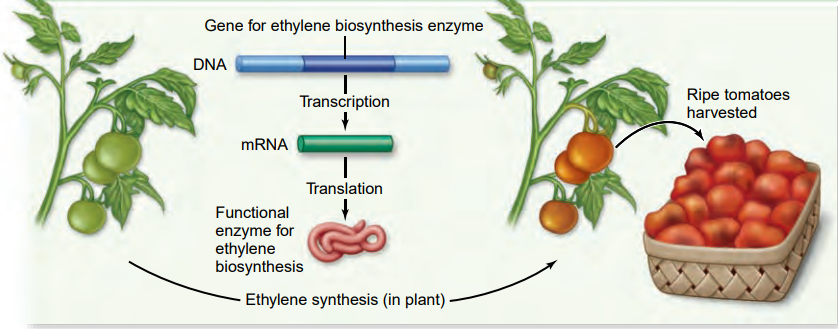

Ethylene is involved in axillary bud inhibition. Auxin, transported down from the apical meristem of the stem, stimulates the production of ethylene, and this hormone suppresses axillary bud development.
Ethylene also suppresses stem and root elongation, even in the presence of other hormones.
Other plant hormones include;
6. Brassinosteroids
Brassinosteroids are named after the cruciferous plant genus Brassica (which includes cabbage and broccoli), from which they were first identified.
However, seeds, fruit, shoots, leaves, and flower buds of all types of plants contain brassinosteroids.
These plant hormones induce water uptake by vacuoles and influence enzymes that alter cell wall carbohydrates, thereby fostering cell expansion.
Mutations that affect brassinosteroid synthesis cause plants to exhibit dwarfism.
Such plants have small, dark green cells because their tissues are unable to expand.
Brassinosteroids also impede leaf drop, help grass leaves to unroll, and stimulate xylem development.
They can be applied to crops to help protect plants from heat, cold, high salinity, and herbicide injury.
Brassinosteroids are chemically related to animal steroid hormones, such as human sex hormones.
However, unlike animal steroid hormones, which bind to receptors in the nucleus or cytosol, brassinosteroids bind to receptors in the plasma membrane.
When they bind brassinosteroids, the membrane receptors initiate a signal transduction pathway that activates transcription factors for brassinosteroid-responsive genes.
Note that Brassinosteroids;
- Promote cell expansion,
- Stimulate shoot elongation,
- Retard leaf drop
- Stimulate xylem development
- Promote stress responses
7. Strigolactones
- It is synthesized at the root tips.
- Regulate branching of roots and stems;
- Promote formation of arbuscular mycorrhizae
- Promote leaf senescence in response to phosphate deficiency
8. Jasmonates
- It is produced in roots, seeds, and probably other tissues
It functioned;
- In defense responses,
- Promote transcription of genes encoding protease inhibitors
- Possible role in plant responses to nutrient deficiencies
9. Salicylic acid
10. Systemin
In summary;
- Hormones and environmental stimuli alter the behaviour of target cells, which have receptors to which signal molecules can bind.
By means of a response pathway that transduces the hormone signal, a signal can induce changes in the cell’s shape or internal structure or influence its metabolism or the transport of substances across the plasma membrane.
Some plant hormones and growth factors may bind to receptors at the target cell’s plasma membrane, changing the receptor’s shape.
This binding often triggers the release of internal second messengers that diffuse through the cytoplasm and provide a chemical signal that alters gene expression.
- Second messengers usually act by way of a reaction sequence that amplifies the cell’s response to a signal.
The sequence activates a series of proteins, including G proteins and enzymes that stimulate the synthesis of second messengers (such as IP3) that bind ion channels on the endoplasmic reticulum.
Binding releases calcium ions, which enter the cytoplasm and activate protein kinases, enzymes that activate specific proteins that produce the cell response.
- At least eight classes of hormones govern flowering plant development, including germination, growth, flowering, fruit set, and senescence.
- Auxins, mainly IAA, promote the elongation of cells in the coleoptile and stem and govern apical dominance, among other effects.
- Cytokinins stimulate cell division, promote leaf expansion, and retard leaf senescence.
- Strigolactones exuded from roots promote the development of arbuscular mycorrhizae. Those transported in xylem sap regulate lateral branching in shoots and roots
- Gibberellins promote stem elongation and help seeds and buds break dormancy.
- Ethylene promotes the triple response in seedlings, senescence, and fruit ripening, and abscission.
- Brassinosteroids stimulate cell division and elongation.
- Abscisic acid (ABA) promotes stomatal closure (including in response to drought stress) and may trigger seed and bud dormancy.
- Jasmonates help regulate growth and have essential roles in defense.
For further reading and Reference:
- (http://youtube.com)
- Reece, J. B., Urry, L. A., Cain, M. L., Wasserman, S. A., Minorsky, P. V., & Jackson, R. B. (2014). Campbell biology (10th ed.). Pearson.
- Mader, S. S. (2010). Biology (10th ed.). McGraw-Hill Higher Education.
Join Enlighten Knowledge WhatsApp Channel.
Join Enlighten Knowledge Telegram platform.






